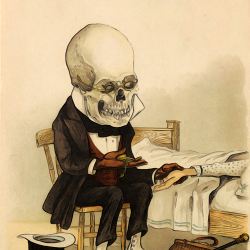Once a long time ago, doctors made house calls. If you couldn’t reach the office, the doctor came to you. Telemedicine has been a pale but viable replacement. A new smartphone attachment brings a more helpful home visit closer to reality.
Doctors made house calls in the days when they had a small range of medications and therapies to offer and didn’t have immediate access to X-rays or ultrasounds. Today, of course, the range of therapeutics that a doctor may employ will not fit into their black bag, and while a small ultrasound could be moved about, educating front-line physicians in using those machines and reading the resulting images lags.
Telemedicine, the unintended consequence of COVID-19, has made it far easier to project physicians into your home, but by and large, these interactions are limited to conversations. Capturing something as simple as a patient’s vital signs remains a hurdle. While there are easily used digital devices for measuring one’s temperature, pulse rate, or oxygenation, few individuals can measure blood pressure.
Researchers at UCSF have developed a BPClip that uses a bit of plastic, an almost ubiquitous smartphone, and some physics to replace the blood pressure cuff, or as we in the trade call them, sphygmomanometer – a mash-up of the Greek sphygmos or "pulse," and the French manometer or "pressure meter.”
Ars Technica describes the underlying physics of the device that clips onto the flashlight portion of a smartphone. The amount of light transmitted through your finger varies with your heartbeat. During the heart’s contraction, systole, more blood in your finger results in less light transmission; during the relaxation phase, diastole, blood flow slows, and the least amount of blood is present, resulting in more light transmission. The transmission of light is also the underlying principle of those little devices we put on our fingers to measure blood oxygenation.
To correlate blood flow with pressure, the BCClip has a spring that your finger pushes down upon, increasing the pressure in your finger and impeding, slowing, and then stopping the blood flow. When pushing down fully, there is no light for the camera to see; as you slowly ease up, more blood flows, and the light is detected.
The BCClip’s software can internally calibrate the pressure applied on the spring and correlate that with the changing light related to the first initial movement of blood, systole, and the constant flow of blood, diastole.
Another component of the physical examination, listening to our heart, lungs, and abdomen, has already been digitized. A wealth of stethoscopes can record and transmit these sounds via Bluetooth technologies. The remaining component of a physical examination, the laying on of hands, has yet to find a digital or remote equivalent. What passes for abdominal palpation in most offices is cursory at best, and the art of examining the abdomen for enlargement of organs and tenderness has largely been supplanted by ultrasound examination. A study comparing the abdominal findings in children where there was a concern about appendicitis or another inflammatory problem among pediatric, emergency, and surgical trainees and attendings found
“No component of the abdominal examination appears to be consistently reliable.”
Telemedicine has been used for several years before COVID, especially in the setting where it was easier for the patient to remain where they are – at work or in prison.
Source: Ultra low-cost smartphone attachment measures blood pressure at home Ars Technica

